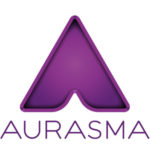
Note: this is an archived page – Aurasma, which later became referred to as HP Reveal, was shuttered by HP in February 2020. Auganix does not have any affiliation with Aurasma/HP Reveal. For support questions relating to the now discontinued Aurasma platform, you should reach out to HP.
Aurasma was an augmented reality (AR) platform. Aurasma was started by UK software company Autonomy, which was acquired by Hewlett-Packard Enterprise (HPE) in October 2011 in a deal that valued Autonomy at USD $11.7 billion (GBP £7.4 billion). After the acquisition, the company operated as HP Autonomy, with the Aurasma app becoming referred to as ‘HP Reveal’.
The app was available as a software development kit or as a free app for iOS and Android-based mobile devices. Aurasma’s image recognition technology used the camera on a smartphone or tablet to recognize real world images and then overlay media on top of them in the form of animations, videos, 3D models and web pages.
When the company was operational, it had over 200,000 customers in 100 countries who used its AR platform to turn everyday objects, images, and places into interactive opportunities in order to engage with fans and customers. The Aurasma platform also included a cloud-based studio for creating, managing, and tracking AR campaigns, creative services, a software development kit (SDK), white-label app development, and the Aurasma app, which was available on Google Play and the App Store.
Aurasma Studio was the company’s free web-based portal, which allowed users to create, manage, and publish their own AR content known as ‘Auras’. Almost like Twitter, only for AR content.
Aurasma offered a range of different subscription options to integrate its AR technology. Customers could choose to make content viewable via the main Aurasma app, or were also able to apply for a skinned version of Aurasma that featured their own company branding. An Aurasma SDK was also available for embedding inside of new or existing apps.
Aurasma was designed to be used in four ways:
- Create Auras and see them through the Aurasma app;
- Request a version of Aurasma skinned with bespoke branding;
- Embed the Aurasma SDK into an app;
- Embed Aurasma into a customers’ own manufactured hardware.
Aurasma users were able to make AR content through an online portal called Aurasma Studio. Online registration was free, and it was from there that users were able to start AR campaigns by building an Aura, or augmented reality experience. Once built, Auras could then be shared with the community.
Users could set up and publish a simple Aura (for example, having a poster launch both a video and a button to a website) in less than a minute. Aurasma also offered a Community Support Site, as well as several video tutorials.
On 7 September 2016, UK Software and IT business, Micro Focus, announced its intent to merge with HP Autonomy. The deal was completed almost a year later on September 1, 2017, wherein HP agreed to sell its Autonomy assets to Micro Focus. However, in the years following, Aurasma, which later became referred to as ‘HP Reveal’, was shuttered by HP in February 2020.
